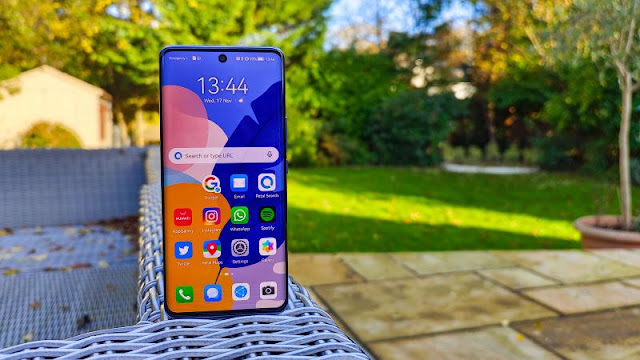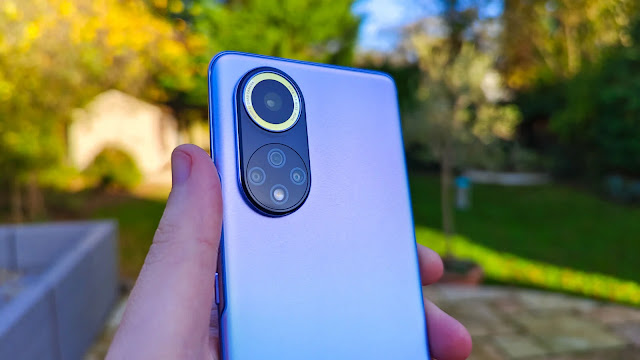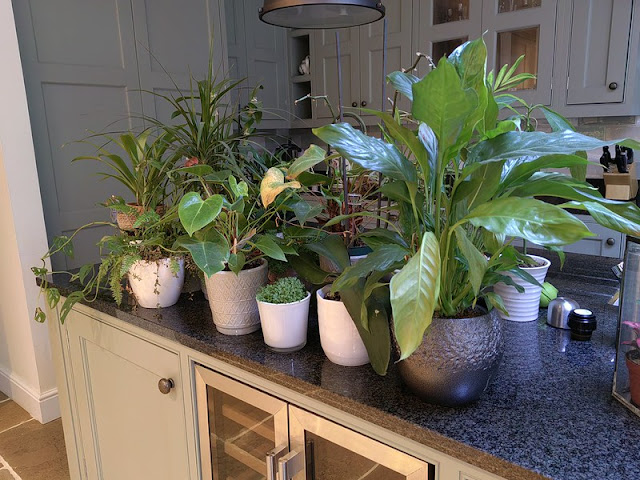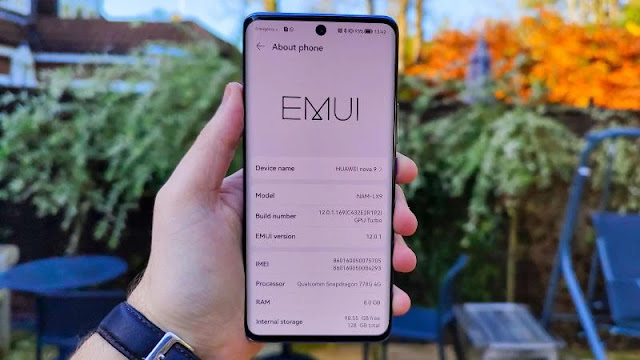The Huawei Nova 9 tells a familiar story: hardcore hardware with a great camera & display, let down by limited Google support and a lack of 5G.
Should I Buy The Huawei Nova 9?
Pros
- Strong main camera
- Great 120Hz display
- Thin & light
Cons
- No Google software support
- No 5G
- Basic secondary cameras
Our Verdict
Price When Reviewed
- Unavailable in the US
Huawei’s phone business may be embattled – to put it mildly – but it hasn’t stopped making new phones. Most of them haven’t made it to European shores however, with one notable exception: the Huawei Nova 9.
It’s not clear why, of all phones, the Nova 9 is the one to reach Europe – especially when we’re still waiting for the P50 Pro – but it really embodies Huawei’s current situation, with impressive hardware hamstrung by familiar software problems.
Design And Build
- Textured finish
- Curved display & body
- Dual ring camera
- No waterproofing
One thing you can’t fault the Nova 9 on is how it looks, especially in the hero ‘Starry Blue’ colour I’ve been testing out, which also has a subtly grippy, textured back.
While this is a large phone thanks to the 6.57in display, it’s still thin at 7.8mm and light at 175g. That makes it feel portable and compact despite the large screen, and curved edges keep it comfortable to hold too.
Note that sadly there’s no water or dust-resistant IP rating for the phone, nor does it use Gorilla Glass on the display, so it’s not as tough as some more expensive devices.
The final thing that does need noting here is that this design is essentially identical to the Honor 50, also available in the UK and Europe, except for the choice of finishes. The phones do differ in some other respects – the Huawei has the better camera, while the Honor has the crucial advantage of Google software – but if it’s the phone’s look that caught your eye then do at least consider the Honor too.
Display and audio
- Large 6.57in display
- 120Hz OLED with high colour coverage
- Non-stereo speakers
This is another fairly strong showing for the Nova 9. The 120Hz OLED panel here is a beauty, covering over a billion colours and handling HDR very nicely.
There’s also an under-display fingerprint reader, which I’ve found to be fast and reliable. Face unlock is available if you prefer, though driven only by a single selfie camera, so it’s not as secure as Apple’s implementation.
On the audio side it’s backed up by a decent enough speaker, though there’s no stereo support. This is fine for a phone, but nothing special. As you might expect, there’s no 3.5mm headphone jack either.
Specs And Performance
- Mid-range Snapdragon 778G chip
- 8GB RAM and 128/256GB storage
- 4G only
The Nova 9 is a firmly mid-range device, and so uses Qualcomm’s Snapdragon 778G chipset. It’s paired with 8GB of RAM and either 128GB or 256GB of storage, with availability varying a bit by market.
This isn’t the fastest or most powerful phone on the market, but it’s got more than enough power for the average user. It’s smooth and fluid even when multi-tasking, and there’s enough oomph to run any modern smartphone game too.
Looking at our benchmark results, you’ll see that in the CPU-focussed Geekbench 5 the Nova 9 holds its own against all but the most powerful flagship and gaming phones, and doesn’t actually lag too far behind those anyway.
There is one big caveat looming over the Nova 9’s chipset though. One of the quirks of the US government’s trade restrictions on Huawei is that while the company can buy smartphone chipsets from Qualcomm, it can’t buy 5G-enabled chips. That means that as powerful as this phone is, it’s 4G-only. You may not mind this, especially if you live in a relatively rural area or a country with limited 5G uptake, but it definitely hurts if you’re looking to futureproof your phone purchase.
Battery And Charging
- Full-day battery
- 66W wired charging
- No wireless charging
Battery life isn’t exactly a strength of the Nova 9 – but it’s certainly not a weakness either.
The 4300mAh battery here is enough for the phone to last a day’s use fairly comfortably, but not enough to stretch it to two days unless you’re an exceptionally light user. Fundamentally that makes the battery life fairly average for the modern market – you can easily find phones that last longer, but this is far from the worst out there.
It’ll do the job and last the day though, and that’s really what matters.
The downside is that there’s no wireless charging at all, but in fairness that’s to be expected at this price – you’d expect to spend a fair bit more to find wireless charging support.
Camera
- Excellent 50Mp main camera
- OK ultrawide
- Solid selfie shooter
If there’s one bit of phone hardware that Huawei excels at, it’s the camera. This is arguably the reason there’s still interest in the company’s flagship P50 phones without Google or 5G, as plenty of people will make that sacrifice in the name of what could be the best phone camera around.
The 50Mp main camera, encased in its own circular housing, uses Huawei's RYYB pixel arrangement, which the company prefers especially for low light performance - though frustratingly here it isn't combined with optical image stabilisation (OIS) which is key to really excellent night photography.
In any case, photos here broadly impress. In daylight the main camera is exceptional, with rich colours and vivid detail in a range of conditions. In darker lighting results are good, but the lack of OIS does show - when the camera gets it right you'll find well exposed, detailed night mode photos with surprisingly accurate colour, but every now and then a shot will come back useless because there just fractionally too much camera shake and the phone's electronic stabilisation couldn't keep up.
On the rear you'll also find an 8Mp ultrawide and 2Mp macro and depth sensors. These are fine, but forgettable. The ultrawide will do the job in decent lighting, but there's a marked drop in detail compared to the main lens, and colours tend to be washed out. The difference is even more marked in low light.
You can film 4K@30 video with the rear cameras, and there's also a dedicated vlogging mode that lets you record split-screen and picture-in-picture video with two lenses at once, including changing between them on the fly.
It's only fair at this point to flag that the camera is one area where the Nova 9 does undoubtedly best the Honor 50. While the setups are mostly similar, the 50Mp main camera here is clearly superior to Honor's 108Mp sensor, despite the lower resolution. No doubt Huawei's unique image processing software and algorithms play their part too, but in any case the result is that this is a clear edge for the Nova 9 if you are trying to compare the two handsets.
Software
- Runs EMUI 12
- Not Android or HarmonyOS
- No Google Mobile Services
The more things change, the more they stay the same.
In one sense, the Nova 9 offers a fairly new software experience, in EMUI 12, but in another there are some very familiar Huawei problems here.
That said, I’ve used HarmonyOS on the MatePad Pro, and EMUI 12 is very similar. Uncannily so. So much so, that you might wonder if this is really HarmonyOS by another name.
I can’t speak to the source code, but I can confirm that this features touches like the iOS-esque control centre and Huawei ecosystem support that is found in HarmonyOS. Regardless of what this is at a technical level, in practical terms this is an extremely similar software experience to HarmonyOS.
Huawei has worked hard over the last few years to work around this problem, and there are some clever solutions. If you’re coming from a previous Android device you can transfer many of your apps over to the Nova 9, and the company’s Petal search engine does a good job of finding .apk files that let you install more apps too.
This is all well and good, but despite Huawei’s best efforts there remain some apps you simply cannot install, and others that will install but not run because they rely on Google’s servers. Others have stranger quirks – WhatsApp will run, but can’t access any Android (or iOS) chat backups, so you’ll be starting from scratch.
This is a smooth, attractive OS that’s easy to navigate and packs plenty of customisation options. But it’s only a viable option for those who are technically minded enough to work around its limitations.
Price And Availability
The Nova 9 is available now in Europe, where it costs €499 for the 128GB model, and €549 for the 256GB variant. You can buy it directly from Huawei, or from Amazon and other retailers.
Huawei has clearly worked to hit an aggressive price point here to combat scepticism about the phone’s inherent deficiencies. The result is that this offers one of the better cameras at this price, along with competitive specs.
There are other mid-range phones to consider. The OnePlus Nord 2 is another strong competitor, with a decent camera and excellent specs for less than the Nova 9, while you don’t have to spend that much more to get the Google Pixel 6 for an even better camera. And yes, the Google phone does of course run Google.
Verdict
There’s a lot to like about the Nova 9. It looks great, the display is sharp, and the main camera is a real triumph for the price – even if the accompanying ultrawide isn’t much to write home about.
But that’s still not enough to make this phone worth it for the average user. With no 5G networking and no support for the Google Play Store, the Nova 9 simply doesn’t add up for most people, especially in the fiercely competitive mid-range market.
Rival devices – especially the Honor 50 – offer comparable specs without suffering from these major compromises.
At a much lower price the Nova 9’s limitations might be more forgivable, but as it is this is mostly a curio for the faithful, whether that’s lovers of Huawei hardware or those intrigued by the company’s efforts to carve out its own software space.
For the rest of us, there are simply better phones elsewhere.
Specs
- 6.57in 120Hz curved Full HD+ (2340x1080) OLED display
- Always-on display functionality
- In-display fingerprint sensor
- 50Mp main camera, f/1.9, PDAF, EIS
- 8Mp ultrawide camera, f/2.2, 120° FoV
- 2Mp macro camera, f/2.4
- 2Mp depth sensor
- 32Mp hole-punch front camera, f/2.2
- USB-C
- Dual SIM
- 4300mAh battery
- Wired charging up to 66W
- Qualcomm Snapdragon 778G 4G chipset
- 8GB RAM
- 128/256GB storage
- EMUI 12
- WiFi 6
- Bluetooth 5.2
- NFC
- 175g
- 160 x 73.8 x 7.8mm


























0 comments:
Post a Comment